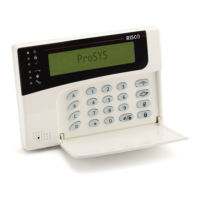6 ProSYS Installation and Programming Manual
Installing ProSYS
This ProSYS Installation and Programming Manual details how to install the ProSYS
hardware and to program the ProSYS Main Panel, as described in the following main steps:
♦ Step 1: Mounting the Main Panel (Chapter 2)
♦ Step 2: Wiring the Main Panel (Chapter 2)
♦ Step 3: Identifying and Wiring Keypads and Expansion Modules (Chapter 3)
♦ Step 4: Adding Modules (Chapter 3)
♦ Step 5: Applying Power (Chapter 3)
♦ Step 6: Programming the ProSYS (Chapters 4 and 5)
♦ Step 7: Programming within the User Functions Mode (Chapter 6)
NOTE:
While this manual describes all of the above steps, the section on programming the Main Panel comprises
the bulk of the information, as it covers all the programmable functions that can be performed using the
keypad.
ETL NOTE:
This document describes how to install, wire and program the ProSYS security system and the
accessories attached, to comply with UL compatible standards as tested and listed by ETL.
The system is listed to the following standards:
Central-Station Burglar Alarm Units, ANSI/UL 1610
Digital Alarm Communicator System Units - ANSI/UL1635
Police Station Connected Burglar Alarm Units and Systems - ANSI/UL365, Household
Fire Warning System Units - ANSI/UL985
Proprietary Burglar Alarm Units and Systems ANSI/UL1076
Household Burglar-Alarm System Units, ANSI/UL 1023
Preliminary Standard for Household Burglar Alarm System Units - ULC C1023 Standard for
Residential Fire Warning System Control Units - ULC-S545-02
About Wire
The proper use of wire and cable is necessary for the successful installation and operation of
the ProSYS system. It is important to select wire of the correct thickness to minimize power
loss and ensure reliable system operation. Take into account both the installation's current
requirements and the wiring distances involved. The following tables provide useful
information to help make your installation trouble-free.
ETL NOTES:
Wiring shall be done according to the National Electrical code ANSI/NFPA 70. Use a min gauge of 22AWG
for all wiring.
Make sure to route wires away from any sharp edges or other parts which can cause.

